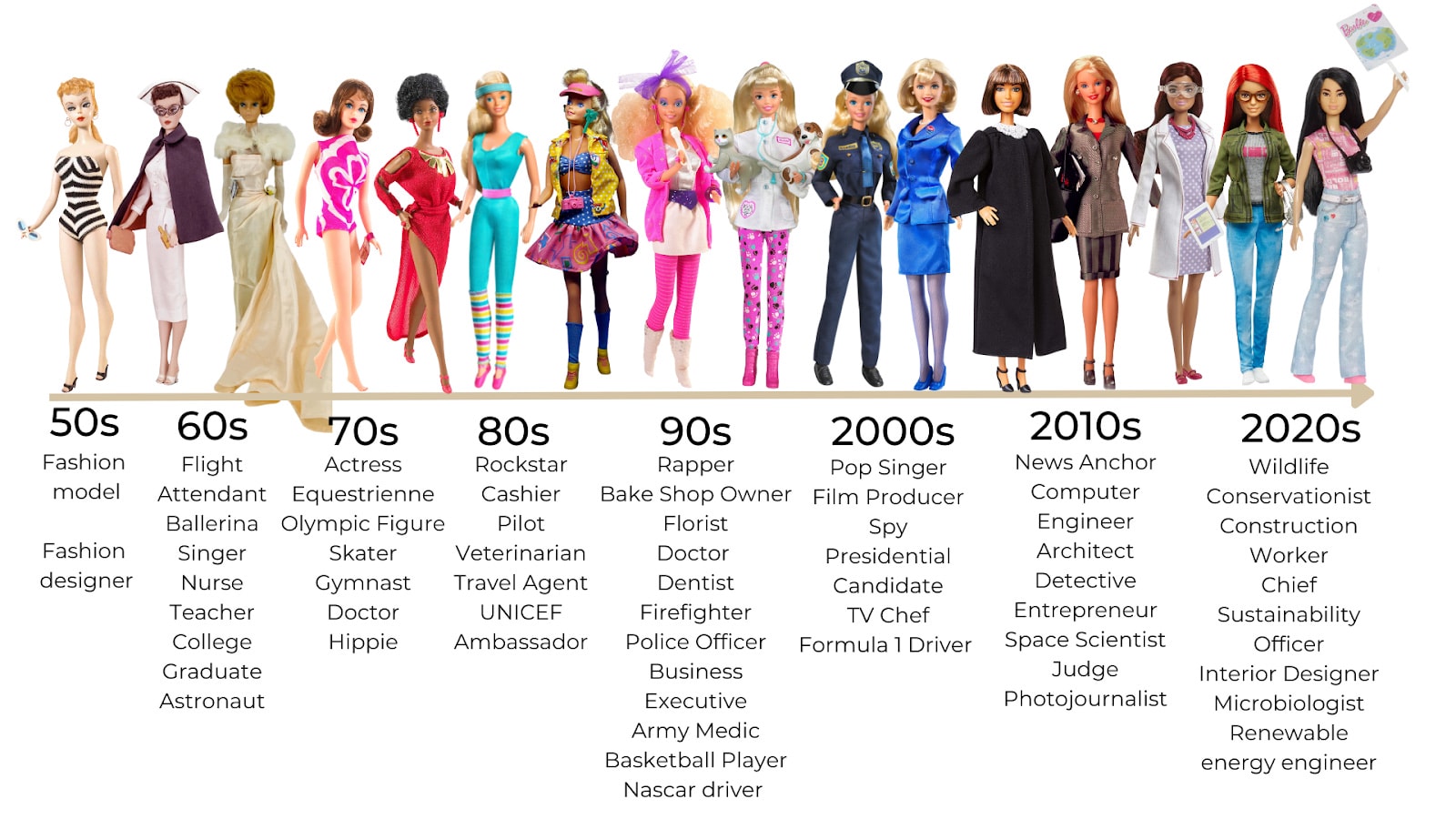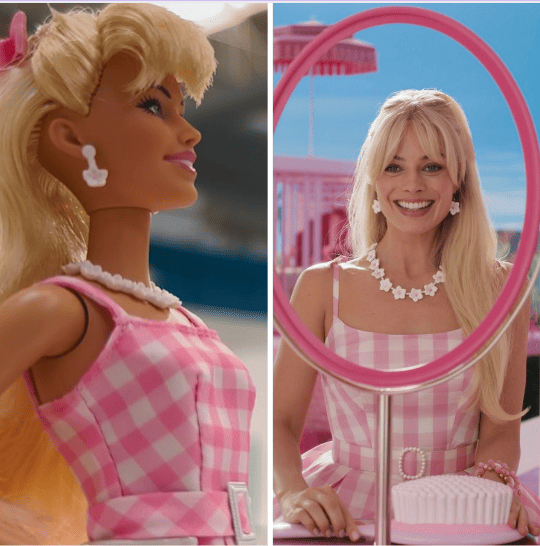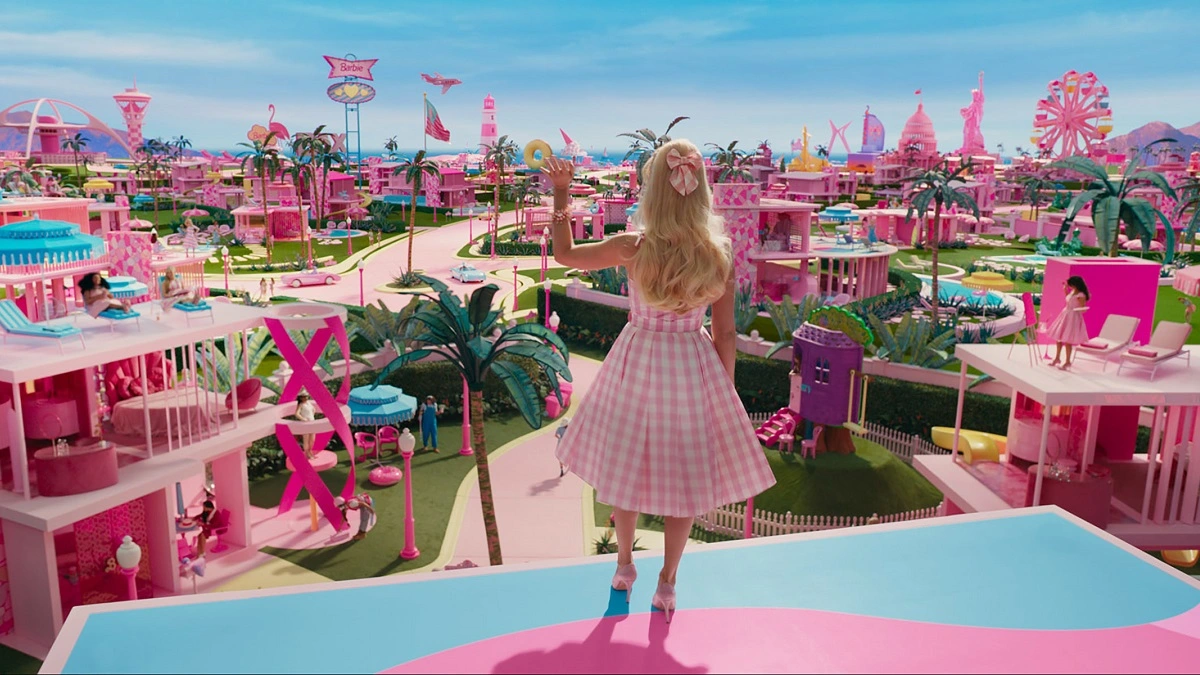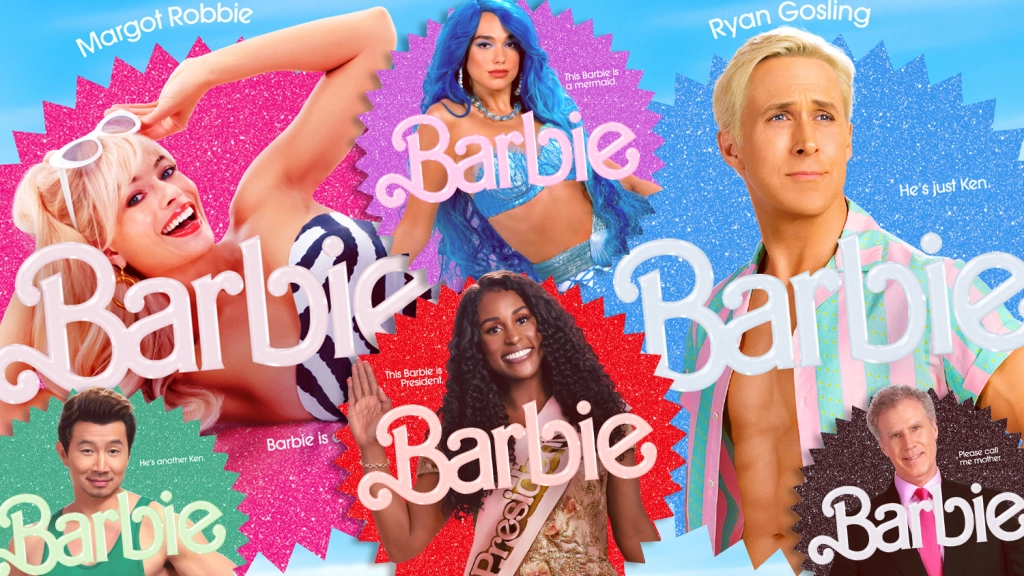
Authors: Lizzie Pruneda, Leslie Carvajal, and Brittany Wedding
It’s A Barbie World
Even When It Comes To Marketing!
Barbie, created by Mattel in 1959, has become one of the most successful and iconic toy brands in history. This blog post explores the factors contributing to Barbie’s enduring success as a brand, including its ability to adapt to cultural changes, resonate with diverse audiences, and maintain a strong brand identity.
Case Study: Timeline and The Success of Barbie as a Brand
Evolving with the Times:
Barbie’s success lies in its ability to evolve and stay relevant across generations. The brand consistently updates its dolls, fashion lines, and playsets to reflect changing trends, cultural shifts, and advancements in society. By embracing diversity, inclusivity, and innovation, Barbie has remained a relevant and aspirational brand for over six decades.
Cultural Relevance and Representation:
Barbie’s commitment to cultural relevance has played a pivotal role in its success. The brand has continuously expanded its doll lineup to include a wide range of ethnicities, body types, and professions, promoting inclusivity and representation. Barbie’s diverse dolls enable children to see themselves and their aspirations reflected in the brand, fostering a deep connection and loyalty.
Strong Brand Identity:
Barbie has established a strong brand identity that embodies fashion, imagination, and empowerment. The brand’s signature pink packaging, the iconic Barbie logo, and the instantly recognizable doll design have become synonymous with Barbie. This consistent branding and distinctive visual identity have contributed to Barbie’s strong presence in the market and its ability to stand out among competitors.

https://grounded.substack.com/p/barbie-was-the-first-avatar-the-crisis
Multi-Dimensional Marketing Strategies:
Barbie’s success can be attributed to its multi-dimensional marketing strategies. The brand effectively utilizes traditional advertising, television commercials, and print media to reach its target audience. Additionally, Barbie has embraced digital marketing, social media engagement, and influencer collaborations to connect with tech-savvy children and parents. By staying on top of emerging marketing channels, Barbie has maintained its relevance in a rapidly changing digital landscape.
Licensing and Partnerships:
Barbie’s strategic collaborations and licensing agreements have expanded its reach and solidified its position as a global brand. The brand has partnered with renowned designers, entertainment franchises, and cultural icons, resulting in limited-edition dolls, themed playsets, and cross-promotional campaigns. These collaborations not only generate excitement but also attract new audiences and keep the brand at the forefront of popular culture.
Barbie’s enduring appeal lies in its ability to empower children’s imaginations, promote inclusivity, and inspire them to dream big. Through continuous innovation and strategic brand management, Barbie has solidified its place as a timeless and influential brand in the toy industry. Barbie’s enduring popularity can be attributed to her ability to adapt and stay relevant to the changing times.
The History of Barbie and the New Barbie Movie
The new Barbie movie aligns with the history of Barbie by embodying the brand’s core values of empowerment, inclusivity, and imagination. Throughout its history, Barbie has evolved to reflect societal changes and empower children to dream big. The movie continues this tradition by telling a story that celebrates diversity, encourages self-expression, and promotes the importance of embracing one’s uniqueness. Like the various iterations of Barbie dolls over the years, the movie showcases a diverse cast of characters, representing different backgrounds, ethnicities, and talents. This inclusivity aligns with Barbie’s commitment to representing and embracing the diverse world we live in.
Furthermore, the movie emphasizes the power of imagination and encourages children to explore their creativity. Barbie has always been a symbol of possibility and aspiration, and the movie reinforces this message by showcasing characters who dare to dream and overcome challenges. Just as Barbie has been a source of inspiration for young girls throughout its history, the movie aims to inspire audiences of all ages. It captures the essence of Barbie’s legacy, showcasing the brand’s commitment to empowering individuals and encouraging them to be true to themselves.
The new Barbie movie aligns with the history of Barbie by embodying the brand’s core values of empowerment, inclusivity, and imagination. It continues the legacy of inspiring children to dream big and embrace their uniqueness, just as Barbie has done throughout its iconic history.

https://www.cnn.com/videos/style/2023/06/01/mattel-barbie-doll-margot-robbie-cprog-orig-gr-md.cnn
How the new Barbie movie went viral

1. Compelling Storytelling:
The movie’s storytelling captures the attention and imagination of the audience. By creating well-developed characters, an engaging plot, and a central theme, the movie evokes emotions, entertains, and resonates with viewers. The captivating narrative and relatable experiences of the characters make the story memorable and shareable.
2. Building Hype:
The marketing team behind the Barbie movie has been proactive in generating excitement and anticipation. They released cryptic teaser images and short videos that showcased the film’s unique aesthetic and featured popular actors like Margot Robbie and Ryan Gosling as Barbie and Ken. These teasers piqued curiosity and solidified the movie’s star power, driving interest and buzz.
3. Social Media Engagement & Memes/User-Generated Content:
The marketing team leveraged social media platforms to engage with fans and create a sense of community. They encouraged user participation through interactive experiences and user-generated content related to Barbie. By involving the audience in the marketing campaign, they fostered a connection and amplified the movie’s reach through shares, likes, and comments. The marketing team capitalized on the creative potential of fans by providing images and assets that inspired meme creation. The fans took these materials and transformed them into humorous and relatable content, which further amplified the movie’s presence on social media. Memes have a viral nature, and their widespread sharing contributed to the movie’s visibility and popularity.
For example, Warner Bros. released 24 promotional posters for the live-action Barbie movie, featuring cast members like Margot Robbie, Ryan Gosling, America Ferrera, and Nicola Coughlan. The posters had a consistent style with a sky-blue background and a sparkly starburst, showcasing the cast members emerging from it with the Barbie logo in front.
Fans loved the posters and created memes using the images. Warner Bros. recognized the meme potential and launched the Barbie Selfie Generator, an AI-powered website where users can insert themselves into the posters and receive a Barbie-like catchphrase. This interactive tool became a huge success, generating more buzz for the movie and showcasing the effective use of social media and memes for promotion.
The shareable marketing campaign, along with other strategies like secret plot reveals, experiences, advertising, television, a secret soundtrack, Barbie boxes in theaters, and product licensing, contributed to the viral success of the movie.

https://deadline.com/gallery/barbie-movie-posters/

Strategic Partnerships and Co-Branding:
The Barbie brand has a long history of collaborations and tie-ins with various brands and products. By partnering with other companies, such as clothing brands or toy manufacturers, the movie extends its reach and creates additional marketing opportunities. These collaborations generate cross-promotion and expose the movie to new audiences through co-branded products and joint marketing campaigns.
Merchandising and Licensing:
The movie’s release provides merchandising opportunities, allowing fans to connect with the movie through related products like toys, clothing, and accessories. Licensing deals enable other brands to create and sell merchandise tied to the movie, contributing to its visibility and generating additional revenue.
Effective Use of Digital Platforms:
The marketing campaign for the Barbie movie strategically utilized various digital platforms, including websites, social media, blogs, and video content. This multi-channel approach ensured maximum exposure and engagement with the target audience across different online platforms.
Through a combination of compelling storytelling, strategic marketing techniques, social media engagement, meme culture, partnerships, and merchandising, the new Barbie movie has successfully gone viral. Its marketing campaign has generated widespread buzz and anticipation, making it one of the most anticipated films of the year. Don’t miss it when it hits theaters on July 21st, as the hype extends beyond just Barbie fans.






Leave A Comment
You must be logged in to post a comment.